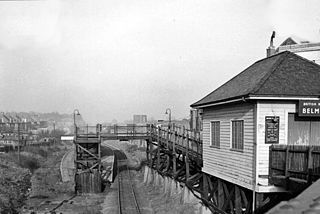
Belmont is a village in the London Borough of Sutton, in South London, England. It is located off the A217 road and near to Banstead Downs in Surrey. It is a suburban development situated 10.8 miles (17.4 km) south-southwest of Charing Cross.

Belmont Park railway station was located on the Armadale/Thornlie line in Perth, Western Australia. It was operated by Transperth serving Belmont Park Racecourse from 1906 until 2013. The station saw 1,358 passengers in the 2013-14 financial year.

Belmont is a suburb in the City of Lake Macquarie New South Wales, Australia, located 20 kilometres (12 mi) from Newcastle's central business district on the eastern side of Lake Macquarie.

The Belmont railway line is an abandoned coal haulage and passenger rail line from Adamstown, New South Wales to Belmont, New South Wales. This was a private railway, being the property of the New Redhead Estate and Coal Company and was generally known as the Belmont Branch. The line closed in December 1991. It has since been converted into a cycleway or rail trail - The Fernleigh Track.

Belmont was a station in Belmont, north-west London on the Stanmore branch line. It was opened on 12 September 1932 by the London, Midland and Scottish Railway as the only intermediate station on a short branch line running north from Harrow & Wealdstone to Stanmore, in anticipation of the Metropolitan Railway opening its own branch line to a new Stanmore station the same year.

Burswood is an inner southeastern suburb of Perth, Western Australia, located immediately across the Swan River from Perth's central business district (CBD). Its local government area is the Town of Victoria Park. Burswood is the location of the State Tennis Centre, Perth Stadium, Belmont Park Racecourse, and the Crown Perth casino and hotel complex.

Stanmore Village railway station was a station in Stanmore, Middlesex in the south of England. Originally called simply Stanmore, it was opened on 18 December 1890 by the Harrow and Stanmore Railway, a company owned by the hotel millionaire Frederick Gordon, as the terminus of the Stanmore branch line, a short branch line running north from Harrow & Wealdstone. Trains were operated by the London & North Western Railway (LNWR).

The Fernleigh Track is a multi-use rail trail near Belmont in New South Wales. The track was constructed in the way of the former Belmont railway line. The project is a joint venture between Newcastle City Council and City of Lake Macquarie. The track extends from Adamstown to Belmont over an approximate distance of 15.5 km (10 mi). The former railway closed in December 1991. The first section between Adamstown and Burwood Road opened in 2003. Construction has continued in stages with the final section between Jewells and Belmont completed in March 2011.

Melling railway station is the terminal station on the single track Melling Line in Lower Hutt, New Zealand. The single platform station serves the suburb of Melling. The station is served by Metlink's electric multiple unit trains.
Belmont railway station was a station on the Hutt Valley Line section of the Wairarapa Line until 28 February 1954, when the Melling-Belmont section of the line on the western side of the Hutt Valley, New Zealand was closed and the through line to Upper Hutt and the Wairarapa rerouted through the centre of the valley.
Silverstream Bridge railway station was a station on the Hutt Valley Line section of the Wairarapa Line in New Zealand from 1908 until 28 February 1954, when the Melling-Belmont section of the line and the first rail bridge at Silverstream was closed. It was replaced by the Silverstream railway station.

Andrews Railway Station was a station on the Hutt Valley Line section of the Wairarapa Line in New Zealand. The line ran up the western side of the valley until 28 February 1954 when the Melling-Belmont section of the line closed.
Pitcaithly’s railway station and siding was a station on the Hutt Valley Line section of the Wairarapa Line in New Zealand north of Melling, which ran up the western side of the valley until 1954. It was replaced by Andrews railway station in 1938.

The Belmont Tramway was a short-lived railway in the south-eastern suburbs of Brisbane, the state capital of Queensland, Australia. It was built by the Belmont Shire Council and opened in 1912. Services were suspended several times and the line formally closed in October 1926.

The Bellarine Railway, formerly the Bellarine Peninsula Railway, is a volunteer-operated steam-driven tourist railway located in Victoria, Australia. It operates on a 16 km section of a formerly disused branch line on the Bellarine Peninsula between the coastal town of Queenscliff and Drysdale, near Geelong.

The Belmont Railway Line was a branch railway in Western Australia that extended from the Eastern Railway at Bayswater to Belmont near the Ascot Racecourse. The line closed in 1956.

The Stanmore branch line was a railway line in Harrow, Middlesex, in the United Kingdom. Located to the north of London, it provided commuter rail services between Harrow and the village of Stanmore. Beginning at Harrow station, the line split off from the West Coast Main Line and followed a short 2.12-mile (3.41 km) route to Stanmore.

Belmont Junction railway station was a railway station that served the civil parish of Belmont in County Durham, North East England, from 1844 to 1857. It was located at the junction between the main line and Gilesgate branch of the Newcastle and Darlington Junction Railway.

Durham (Gilesgate) railway station served the Gilesgate area of Durham City in County Durham, North East England from 1844 to 1857 as the terminus of the Newcastle & Darlington Junction Railway Durham Branch passenger service. Its life as a passenger station was short and it was quickly converted to goods station, a role which it played for more than a century.

















